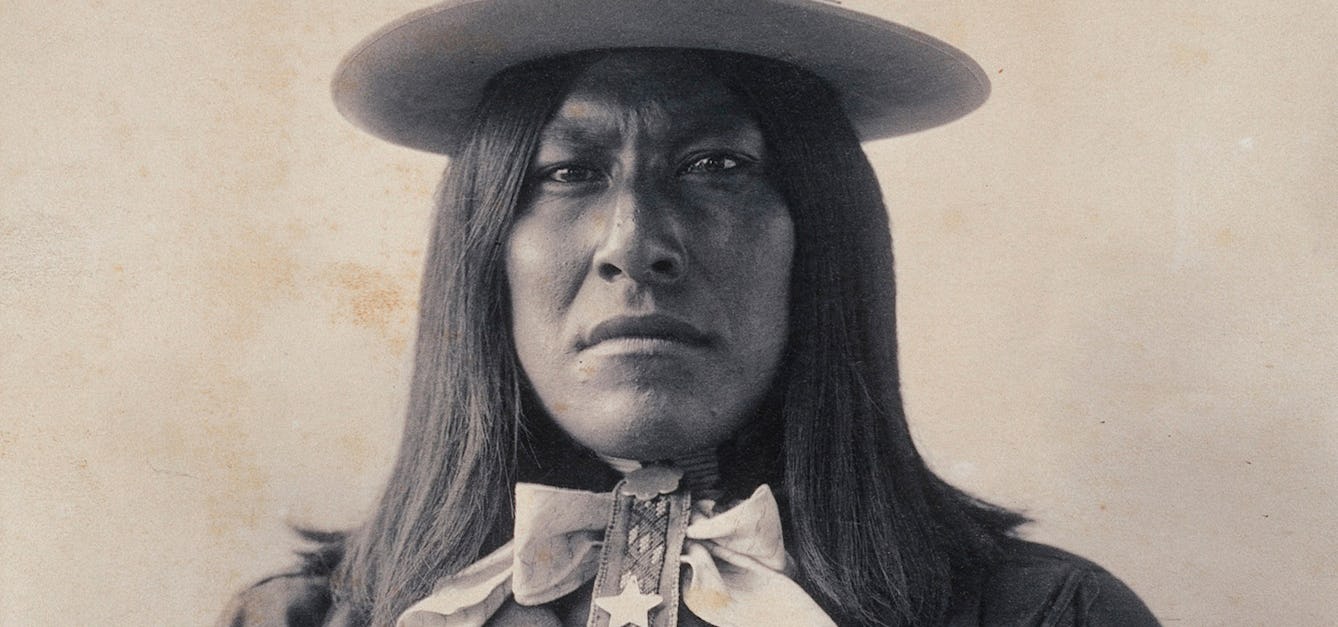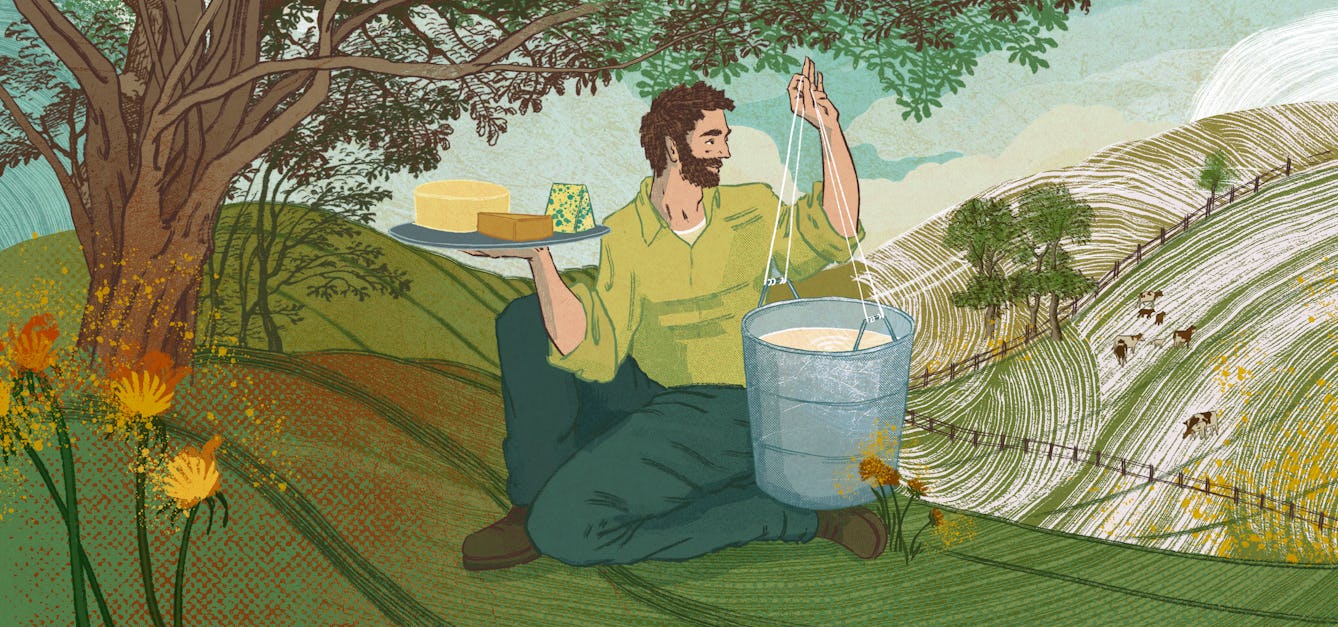Stories

- Article
Native Americans through the 19th-century lens
The stories behind Rinehart's photographs may not be as black and white as they first appear.

- Article
Colonialism and the origins of skin bleaching
The widespread practice of skin bleaching was heavily influenced by the Western colonisation and slavery of African and South Asian countries. Ngunan Adamu explores this toxic history.

- Article
The gym of cartoon men
In men, body dysmorphia can be expressed as ‘bigorexia’ – the belief that your body is too weak and thin – or anorexia. Andrew McMillan explores two sides of the same coin.

- Article
Soil health and dairy farming in the UK
Although healthy soil means more nutritious dairy products, modern intensive farming methods pollute and degrade the environment. However, a regenerative agriculture movement is kicking back against mainstream industrial farming.
Catalogue

- Digital Images
- Online
Erosion of the enamel of the teeth.
- Books
Erosion of the inner table of the skull by hyperplasia of bone-marrow in kala-azar, with extra-medullary formation of blood on the surface of the dura / by C.H. Hu and J.R. Cash.
Hu, C. H.Date: [1927?]
- Digital Images
- Online
SEM bone, erosion of trabeculae
David Gregory & Debbie Marshall
- Books
- Online
On erosion, or notching of the teeth / by Dr. Reid.
Reid, Robert (Dentist)Date: [1848]
- Digital Images
- Online
Cord compression, odontoid erosion







![Pulmonaria officinalis L. Boraginaceae Distribution: Officinalis indicates its medicinal use in early medicine. Europe. Pulmonaria or Lungwort are names for a lichen and a perennial plant in the Boraginaceae. This is the latter. Lyte (1578) has a woodcut of our plant and also calls it Sage of Jerusalem and says it is of ' no particular use in physicke, but is much used in meates and salads with eggs, as is also Cowslippes and Primroses, whereunto in temperature it is much alike.' He lists and describes the lichen separately. Culpeper (1650) said he found many sorts of lunguewort in perusing Authors ' Pulmonari, arborea and Symphytum maculosum [and the latter is our plant, the others the lichen] and that they 'helpe infirmities of the lungues, as hoarseness, coughs, wheezing, shortnesse of breath etc.' Coles (1657) who espouses the Doctrine of Signatures in a way unrivalled by any other English author, might have been expected to confirm the concept that the mottled leaves looked like the cut surface of a lung which indicates their purpose, but he only mentions the lungwort which is a lichen. However, Porta's beautiful book on the Doctrine, Phytognomica (1588), is clear that the plant called Pulmonaria with hairy leaves like a bugloss, spotted white with purple flowers, commonly called 'cynoglossa' [with a woodcut which could be Pulmonaria officinalis] indicate its use for ulcerated lungs, spitting blood, shortness of breath and asthma equally with the lichen with the same name. Lobel & Pena (1570) call it 'PULMONARIA, masculosa folia Borrago, floribus Primula veris, purpureis [PULMONARIA spotted, Borage-leaved, flowers like Primula veris - Cowslips - purple]' and say that women mix the leaves with a little broth and make it into an omelette for lung disorders and to strengthen the heart. Lobel (1576) calls it Maculosa Pulmonaria and describes a white flowered form with a good woodcut. Gerard (1633) uses the same woodcut as Lobel and calls it Pulmonatia foliis Echii, Buglosse Cowslips with red flowers, and a woodcut of a narrow leaved plant as Pulmonaria masculosa, Spotted Cowslips of Jerusalem with red, blue and purple flowers and says 'the leaves are used among pot-herbes. The roots are aso thought to be good against the infirmities of ulcers of the lungs...'. Quincy (1718) writes: '... it has a glutinous juice ... and heals ulcers and erosions. It is commended in coughs and spitting of blood but is little used either in the Shop or Prescriptions. Not used in modern medicine. It is in the family Boraginaceae whose species are often rich in pyrrolizidine alkaloids that cause liver toxicity and liver cancers, but levels in Pulmonaria officinalis may not be significant. Photographed in the Medicinal Garden of the Royal College of Physicians, London.](https://iiif.wellcomecollection.org/image/B0009136/full/600%2C/0/default.jpg)
![Pulmonaria officinalis L. Boraginaceae Distribution: Europe. Pulmonaria or Lungwort are names for a lichen and a perennial plant in the Boraginaceae. This is the latter. Lyte (1578) has a woodcut of our plant and also calls it Sage of Jerusalem and says it is of 'no particular use in physicke, but is much used in meates and salads with eggs, as is also Cowslippes and Primroses, whereunto in temperature it is much alike.' He lists and describes the lichen separately. Culpeper (1650) said he found many sorts of lunguewort in perusing Authors ' Pulmonari, arborea and Symphytum maculosum [and the latter is our plant, the others the lichen] and that they 'helpe infirmities of the lungues, as hoarseness, coughs, wheezing, shortnesse of breath etc.' Coles (1657) who espouses the Doctrine of Signatures in a way unrivalled by any other English author, might have been expected to confirm the concept that the mottled leaves looked like the cut surface of a lung which indicates their purpose, but he only mentions the lungwort which is a lichen. However, Porta's beautiful book on the Doctrine, Phytognomica (1588), is clear that the plant called Pulmonaria with hairy leaves like a bugloss, spotted white with purple flowers, commonly called 'cynoglossa' [with a woodcut which could be Pulmonaria officinalis] indicate its use for ulcerated lungs, spitting blood, shortness of breath and asthma equally with the lichen with the same name. Lobel & Pena (1570) call it 'PULMONARIA, masculosa folia Borrago. floribus Primula veris, purpureis [PULMONARIA spotted, Borage-leaved, flowers like Primula veris - Cowslips - purple]' and say that women mix the leaves with a little broth and make it into an omelette for lung disorders and to strengthen the heart.. Lobel (1576) calls it Maculosa Pulmonaria and describes a white flowered form with a good woodcut. Gerard (1633) uses the same woodcut as Lobel and calls it Pulmonatia foliis Echii, Buglosse Cowslips with red flowers, and a woodcut of a narrow leaved plant as Pulmonaria masculosa, Spotted Cowslips of Jerusalem with red, blue and purple flowers and says 'the leaves are used among pot-herbes. The roots are aso thought to be good against the infirmities of ulcers of the lungs...'. Quincy (1718) writes: '... it has a glutinous juice ... and heals ulcers and erosions. It is commended in coughs and spitting of blood but is little used either in the Shop or Prescriptions'. Not used in modern medicine. It is in the family Boraginaceae whose species are often rich in pyrrolizidine alkaloids that cause liver toxicity and liver cancers, but levels in Pulmonaria officinalis may not be significant. Photographed in the Medicinal Garden of the Royal College of Physicians, London.](https://iiif.wellcomecollection.org/image/B0009135/full/282%2C/0/default.jpg)
![Pulmonaria rubra L. Boraginaceae A red-flowered species, mentioned in 16th and 17th herbals, but with the same properties as officinalis. Distribution: Europe. Pulmonaria or Lungwort are names for a lichen and a perennial plant in the Boraginaceae. This is the latter. Lyte (1578) has a woodcut of our plant and also calls it Sage of Jerusalem and says it is of 'no particular use in physicke, but is much used in meates and salads with eggs, as is also Cowslippes and Primroses, whereunto in temperature it is much alike.' He lists and describes the lichen separately. Culpeper (1650) said he found many sorts of lunguewort in perusing Authors 'Pulmonari, arborea and Symphytum maculosum [and the latter is our plant, the others the lichen] and that they 'helpe infirmities of the lungues, as hoarseness, coughs, wheezing, shortnesse of breath etc.' Coles (1657) who espouses the Doctrine of Signatures in a way unrivalled by any other English author, might have been expected to confirm the concept that the mottled leaves looked like the cut surface of a lung which indicates their purpose, but he only mentions the lungwort which is a lichen. However, Porta's beautiful book on the Doctrine, Phytognomica (1588), is clear that the plant called pulmonaria with hairy leaves like a bugloss, spotted white with purple flowers, commonly called 'cynoglossa' [with a woodcut which could be Pulmonaria officinalis] indicate its use for ulcerated lungs, spitting blood, shortness of breath and asthma equally with the lichen with the same name. Lobel & Pena (1570) call it 'PULMONARIA, masculosa folia Borrago. floribus Primula veris, purpureis[ PULMONARIA spotted, Borage-leaved, flowers like Primula veris - Cowslips - purple] and say that women mix the leaves with a little broth and make it into an omelette for lung disorders and to strengthen the heart. Lobel (1576) calls it Maculosa Pulmonaria and describes a white flowered form, with a good woodcut. Gerard (1633) uses the same woodcut as Lobel and calls it Pulmonatia foliis Echii, Buglosse Cowslips with red flowers, and a woodcut of a narrow leaved plant as Pulmonaria masculosa, Spotted Cowslips of Jerusalem with red, blue and purple flowers and says 'the leaves are used among pot-herbes. The roots are aso thought to be good against the infirmities of ulcers of the lungs...'. Quincy (1718) writes: '... it has a glutinous juice ... and heals ulcers and erosions. It is commended in coughs and spitting of blood but is little used either in the Shop or Prescriptions. Not used in modern medicine. It is in the family Boraginaceae whose species are often rich in pyrrolizidine alkaloids that cause liver toxicity and liver cancers, but levels in Pulmonaria officinalis may not be significant. Photographed in the Medicinal Garden of the Royal College of Physicians, London.](https://iiif.wellcomecollection.org/image/B0009137/full/282%2C/0/default.jpg)